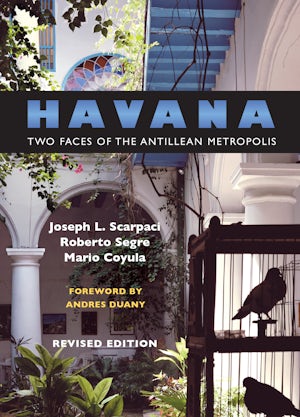Havana
Two Faces of the Antillean Metropolis
Revised Edition
By Joseph L. Scarpaci, Roberto Segre, Mario Coyula
Foreword by Andres Duany
464 pp., 6.125 x 8.75, 48 photos, 33 tables, 17 maps, 11 figs., notes, bibl., index
-
Paperback ISBN: 978-0-8078-5369-6
Published: September 2002 -
E-book EPUB ISBN: 978-1-4696-2064-0
Published: October 2017 -
E-book PDF ISBN: 979-8-8908-7537-2
Published: October 2017
Buy this Book
- Paperback $42.50
- E-Book $29.99
Awards & distinctions
A 1998 Choice Outstanding Academic Title
From the colonial and early republican periods, through the 1959 revolution, and into the post-Soviet era and today, the authors trace Havana's physical evolution and place it in the context of important political, economic, and cultural developments. This new edition--which has been completely revised, redesigned, and updated since the book's original publication in 1997--also highlights recent restoration efforts in Old Havana, commercial development projects throughout the city, and the wide-ranging effects of international tourism.
About the Authors
Joseph L. Scarpaci is Emeritus Professor of urban affairs and planning at Virginia Tech in Blacksburg, Virginia, and serves as Executive Director of the Center for the Study of Cuban Culture + Economy, also in Blacksburg.
For more information about Joseph L. Scarpaci, visit
the
Author
Page.
Roberto Segre (1934-2013) was professor of architecture and urbanism at the Universidade Federal do Rio de Janeiro in Brazil.
For more information about Roberto Segre, visit
the
Author
Page.
Mario Coyula (1935-2014) was an architect and planner in Havana, Cuba.
For more information about Mario Coyula, visit
the
Author
Page.
Reviews
"This book is an extraordinary document, not least because its subject is a truly great city, perhaps the most interesting in the New World."--Andres M. Duany, from the Foreword
"Studded with fascinating photos from the authors' personal collections. . . . A welcome addition to the literature of both international urban studies and the regional geography of the Caribbean Basin. Recommended as highly as possible for Latin America, architecture, planning, and urban studies collections. All levels."--Choice
"An authoritative urban history that covers its development through colonial, republican, and revolutionary periods. . . . This important book is especially relevant in light of anticipated changes that may come to pass in the post-Castro period."--Colonial Latin American Historical Review
"An exciting portrait of one of Latin America's most important cities, Havana takes us beyond the usual coffee-table-book photos of crumbling eighteenth-century archways, emphasizing instead the private experience of Havana's denizens."--Lingua Franca
"Perhaps no three scholars are better qualified to describe and explain the reality of Havana to social scientists interested in urbanity than the authors of this extraordinary book. . . . Such fruitful collaboration between Cuban and American scholars is rare, and in this case the results are rich."--Review of Radical Political Economics
"A rich resource on a wide range of issues associated with the nearly 500 years of growth and transformation of Havana. It is a seminal work that belongs on any Cubanologist's bookshelf, and an essential text for anyone reading to prepare for a trip to the island. . . . It is also an important work for scholars with only a passing interest in the specifics of Havana's built environment, but who also focus on urban history, architectural forms, state socialism, or Cuba's post-Soviet transition."--Environment and Planning A




